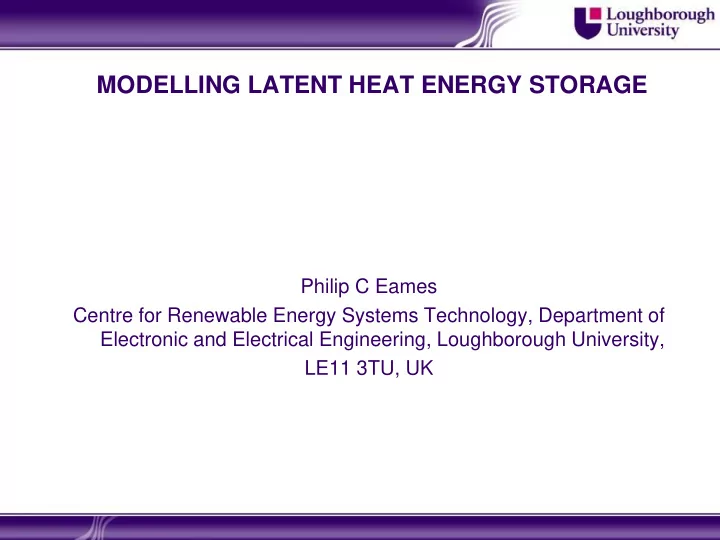

MODELLING LATENT HEAT ENERGY STORAGE Philip C Eames Centre for Renewable Energy Systems Technology, Department of Electronic and Electrical Engineering, Loughborough University, LE11 3TU, UK
PCM must be selected so that charge discharge cycle is close to the required operational temperature regime. High effective energy density can be realised if operation is close to phase change temperature Wide range of materials available with different phase change temperatures For efficient long term operation charging and discharging must occur in a cycle Effective heat transfer into the PCM material is essential
Two and three dimensional transient finite volume models with temperature dependant material properties have been developed to predict heat transfer to and from a PCM, with simulation of the progress of the phase transition front and the free convective heat transfer within the liquid phase. Phase change occurs over a set temperature range. The model allows the enthalpy, to be varied within the temperature of phase change to more accurately simulate real phase change behaviour . The model allows the fluid properties to be varied with temperature in a specified way.
The solution domain for the energy equations encompasses the phase change material and its enclosing container, the solution domain for the momentum equations is limited to that in which liquid phase change material exists. The models employ variable time steps when rapid melting of the phase change material is taking place which enables a stable solution to the equations to be obtained. All equations are solved using the Bi-CGSTAB iterative equation solver allowing significantly larger systems of equations to be solved in a reasonable time when compared to that required for direct solution methods. The program was recently converted to parallel implementation allowing decrease in execution time 8 thread leading to a 5-6 times reduction in simulation time The model can be applied for different PCMs if material properties are known.
Example simulations
Fluid outlet Phase change material Fins t 60 55 50 45 40 35 30 25 20 Time = 30 minutes Fluid inlet
Fluid outlet Phase change material t 60 55 50 45 40 35 30 25 20 Time = 30 minutes Fluid inlet
t 48 46 44 42 Time =300 Seconds 40 38 Outlet 36 34 Insulation 32 Expansion Space 30 PCM 28 26 24 Expansion Space 22 PCM Expansion Space Fins PCM Inlet
t 48 46 44 42 Time =3600 Seconds 40 38 Outlet 36 34 Insulation 32 Expansion Space 30 PCM 28 26 24 Expansion Space 22 PCM Expansion Space Fins PCM Inlet
Staff Dan in position 2 nd RA will join the project in 3 months (Laurence currently working on PCM heat storage) 2 PhD students to join.
Materials characterisation equipment ordered. Test building progressing currently with FM, 5-7 year RF post in the area of Energy storage
Recommend
More recommend